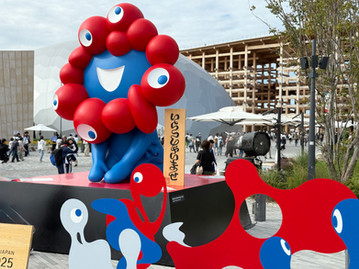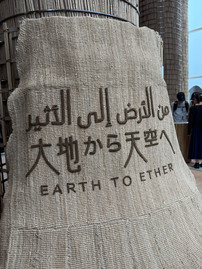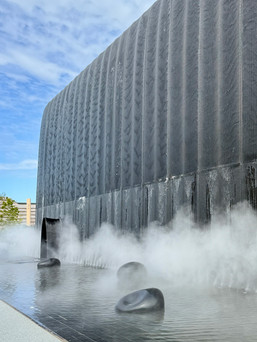Expo 2025 Osaka, Japan
- Desmond

- 2 days ago
- 4 min read
Expo 2025 Osaka, Kansai, Japan was a massive six-month world fair from April 13 to October 13, 2025, on Yumeshima's man-made island in Osaka Bay—focusing on the theme "Designing Future Society for Our Lives." Over 150 countries and orgs shared innovations in health, AI, sustainability, and SDGs through pavilions (like Japan's circular "Between Lives" one with biogas tech), the epic 2km Grand Ring walkway, corporate exhibits (Panasonic, Mitsubishi), and global food/shops. Drew ~25M visitors with immersive demos on urban tech and global issues—Japan's first since 1970.
We were lucky to have some friends who managed to get us some free staff passes to avoid the long queues!

*Grand Ring by Sou Fujimoto*: Epic 2km timber halo (world's largest wooden structure) from hinoki cypress and sugi cedar, inspired by Japanese temples. Walkable paths at ground and 20m up for stunning views—earthquake-proof and eco-focused.
Entrance and Surrounding
The Osaka Expo 2025 "park" was a massive 155-hectare site on Yumeshima's man-made island in Osaka Bay—more like a futuristic urban playground than a traditional park, blending green spaces, pavilions, and tech zones around the theme "Designing Future Society for Our Lives." It ran April 13 to October 13.
Expo 2025 Osaka's design highlights stole the show with innovative, sustainable pavilions blending architecture, nature, and tech—here are some standouts:
• *Japan Pavilion by Nikken Sekkei & Nendo (Oki Sato)*: Demountable rings of cross-laminated timber creating soft, flowing boundaries. It's a "living organism" with biodegradable energy systems, emphasizing endless evolution.
• *Brazil Pavilion by Studio MK27*: Curved metallic mesh canopy mimicking Amazon "Flying Rivers"—vapor-filled interior, ramps to a rooftop artificial river. Modular and waste-minimizing for easy disassembly.
• *France Pavilion by Coldefy & Carlo Ratti Associati*: "Theatrum Naturae" as a sensory path through ecosystems (ascent, discovery, return), ending in a rooftop garden. Prefab natural materials for low-impact coexistence with nature.
• *Qatar Pavilion by Kengo Kuma*: White fabric over scalloped timber, like a modern Bedouin tent—hosts AMO-designed exhibits on culture and future living.
• *Uzbekistan Pavilion by Atelier Brückner*: Humble Silk Road-inspired sugi wood and clay bricks; immersive rotating platform and QR-coded columns tracing material origins. Super sustainable and story-driven.
• *Netherlands Pavilion by RAU Architects & Tellart*: Suspended orb nodding to water heritage and renewables—circular design for energy efficiency.
China
China Pavilion at Expo 2025 Osaka was a standout 3,500 m² self-built gem (one of the largest foreign ones), designed by China Construction Technology Consulting Co., Ltd. (CCTC) and Native Design Research Center. Inspired by ancient bamboo scrolls (shujian), it unfolded like a traditional Chinese calligraphy scroll—elegant curves of bamboo, characters, and motifs blending 5,000 years of heritage with modern green tech.
Kuwait
Kuwait Pavilion at Expo 2025 Osaka was a stunning 3,503 m² "Visionary Lighthouse," designed by LAVA (Laboratory for Visionary Architecture) with NUSSLI as contractor—blending Kuwait's desert heritage, trade history, and hospitality into a sustainable beacon for the "Designing Future Society" theme. It embodied Kuwait's Vision 2035: openness, collaboration, and eco-innovation.
Switzerland
Five interconnected inflatable spheres (like floating bubbles or soap bubbles) embedded in a lush green park-like landscape—ultra-light membrane structure (just 400-450 kg total, 1% of a conventional build) using PVC-coated PES inside and ETFE outside. Supported by curved steel tubes on a concrete slab, all modular, recyclable (post-expo: turned into furniture), and with minimal eco-footprint—the lightest Swiss pavilion ever!
Nordic
Three-level open space as a "fertile barn" for ideas—double-height exhibition hall with immersive tech (projections, interactives) on green transition, well-being, mobility, and circular economies. Visitors flowed through reflective zones inspired by bird flocks/reindeer herds and Japan's Enso symbol, highlighting shared Nordic innovations without borders.
Bahrain
Bahrain Pavilion at Expo 2025 Osaka was a captivating 995 m² "Connecting Seas" (or "Embankment – Anatomy of a Dhow"), designed by Lebanese-French architect Lina Ghotmeh of Lina Ghotmeh—Architecture, with interiors by Bahrain's Shepherd Studio. In the "Empowering Lives" zone facing the sea, it evoked Bahrain's maritime heritage—traditional dhow boats that shaped trade and pearling—while tying into the expo's "Designing Future Society" theme through sustainability and cultural exchange.
Spain
Organic, wave-like structure evoking ocean currents and sun reflections—built with dry-jointed Japanese red cedar, recycled fishing-net signage, and varying-blue ceramics for a Mediterranean vibe. A central plaza and descending blue steps mimic diving into the sea, all modular and low-impact for easy disassembly.
Azerbaijan
A striking sequence of seven monumental, perforated metal arches forming a passageway—each symbolizing a "beauty" (aspects like diverse culture, resources, traditions, sports, tourism, and bridges to the future). They lead to a sleek metallic volume, blending parametric architecture with Eastern/Western vibes for an immersive, bridge-like flow.
Turkeye
Turkey Pavilion at Expo 2025 Osaka was a 1,200 m² cultural crossroads called "Heyday of Civilizations," designed by Turkish team (architects like Emre Arolat and exhibition by ERA) to blend Anatolian heritage from Göbeklitepe (12,000+ years old) to Ottoman glory with a forward-looking vision on sustainability and global ties.
United Arab Emirates
UAE Pavilion at Expo 2025 Osaka was an epic 2,013 m² "Earth to Ether" marvel, designed by the Earth to Ether Design Collective (led by Emirati visionaries like Mariam Almemari and international partners Atelier Brückner, Rimond, and Japanese wood experts)—celebrating UAE's roots in nature/heritage to sky-high innovations in space, healthcare, and sustainability.
Other Pavilions

































































































































Comments